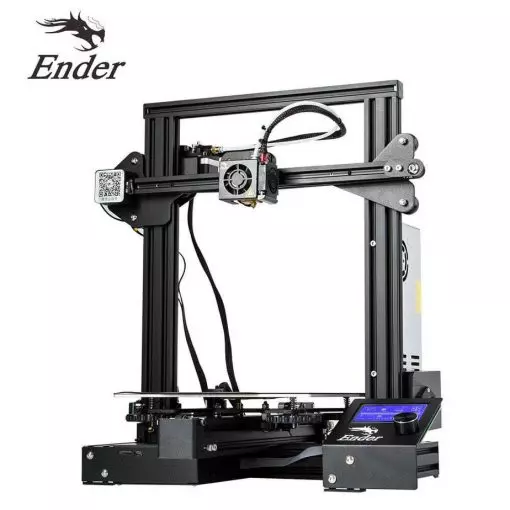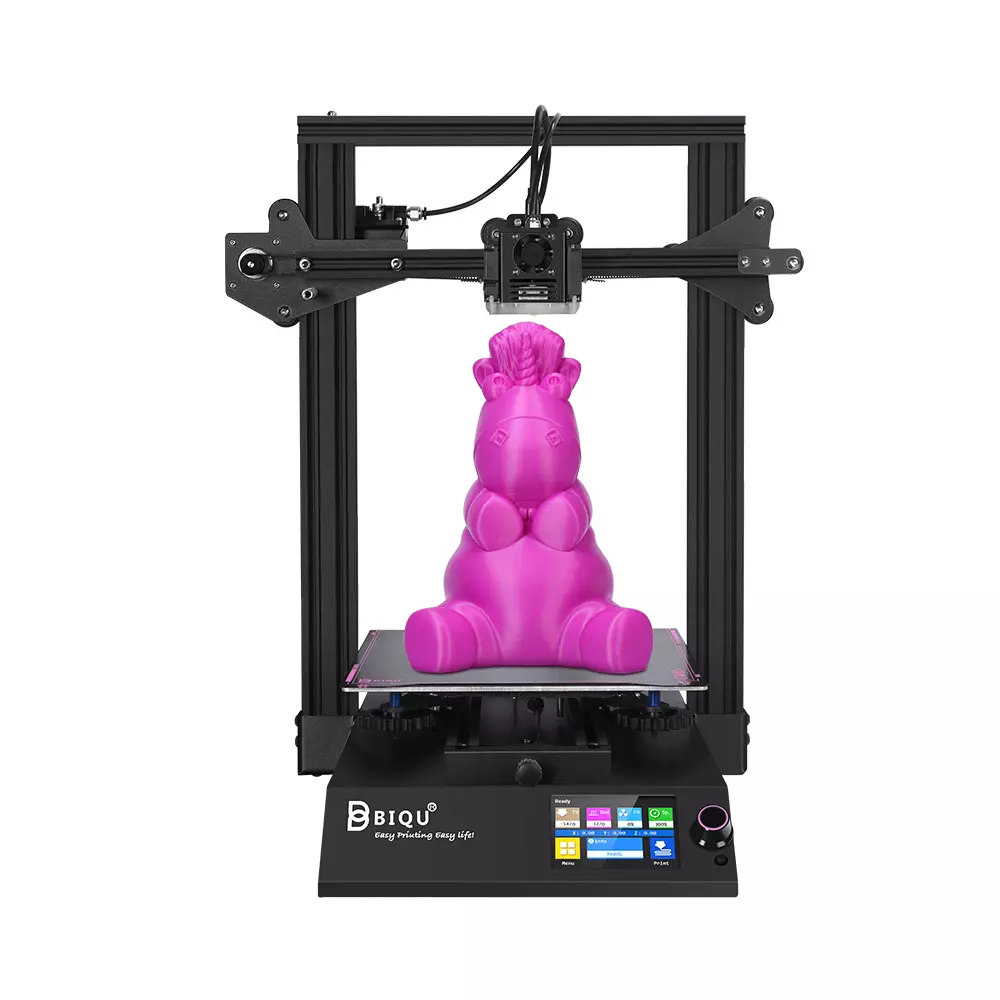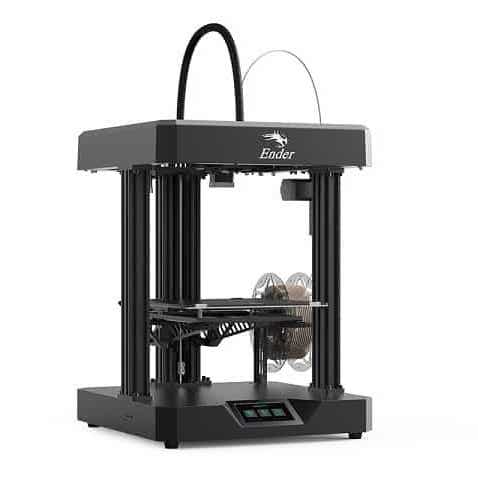Compare Ender 3 vs BIQU B1 vs Ender 7
Comparison between the best 3D printers
Choose the best 3D printer at the best price. The cheapest 3D printers are here.
Buy a 3D printer here with 3D Fila.
 |
 |
 |
|
| Model | Ender 3[BUY Ender 3] |
BIQU B1 |
Ender 7[BUY Ender 7] |
| Printing Material | Filament | Filament | Filament |
| Estimated price | $210,00 | $269,00 | $429,00 |
| Fabricante | Creality 3D | BigTreeTech | Creality 3D |
| Release Year | 2018 | 2020 | 2021 |
| Print Volume [mm] | 220x220x250 | 235x235x270 | 250x250x300 |
| Printer Size [mm] | 440x440x465 | 412x402x492 | 430x460x570 |
| Weight [kg] | 6,62 | 8,00 | 17,2 |
| Power Loss Recovery | NO | YES | YES |
| Enclosed printer | NO | NO | NO |
| Bed Leveling | Manual | Manual | Manual |
| Filament End Sensor | NO | YES | YES |
| Bed type | Heated | Heated | Heated |
| Power supply system | Bowden | Bowden | Bowden |
| Standard nozzle | 0,4 | 0,4 | 0,4 |
| Maximum Nozzle Temperature [°C] | 255 | 250 | 260 |
| Maximum Bed Temperature [°C] | 110 | 100 | 100 |
| Maximum printing speed [mm/s] | 180 | 100 | 250 |
| Filament holder | YES | YES | YES |
| Camera for supervision | NO | NO | NO |
| Recommended filaments | PLA, TPU, ABS, PETG | PLA, TPU, ABS, PETG | PLA, PETG, Tritan, Flex, ABS |
| Recommended slicers | Cura, Simplify, Slic3r | Cura, Simplify, Slic3r | Cura, Simplify, Slic3r, IdeaMaker |
| Maximum Resolution [mm] | 0,1 | 0,1 | 0,1 |
| Processor | 8 bits | 32 Bits BTT SKR V 1.4 | Creality CR-FDM V.2.4.S1_V101 32bits |
| Display | Mono | Touchscreen TFT 3,5'' | Display touchscreen 4,3'' |
| Power Supply | 24V / 270W | 24V / 360W | 110/220V / 350W |
| Connectivity | SD / USB | SD / USB | SD / USB |
| Operating systems | Windows, Mac, Linux | Windows, Mac, Linux | Windows, Mac, Linux |
| Date of registration in the system | 2021-04-13 | 2021-04-14 | 2022-11-04 |
| Release date | 2018 | 2020 | 2021 |
| Extra features | The Ender 3 V1 is a DIY assembly 3D printer, a sales leader since 2017, standing out for its cost-benefit. With a wide printing capacity, it has a CNC machined structure for precision and stability. It offers high-precision prints with low noise, thanks to its innovative V-profile and pulleys. It has a self-adhesive magnetic platform for easy removal of models and excellent adhesion. The Ender 3 heats up quickly, reaching 100°C in 5 minutes, ideal for agile prints. It includes protection against power failures, allowing you to resume printing after interruptions, saving time and material. | The BIQU B1 is an advanced 3D printer with a silent 32-bit BTT SKR V1.4 motherboard and ARM Cortex-M3 CPU, offering DIY interfaces (I2C, SPI, WiFi) and dual Z-axis. Its dual BTT B1 TFT35 V3.0 operating system allows real-time monitoring and multiple printing modes, including G-code visualization effects. It stands out for its BIQU SSS (Super Spring Steel), ensuring easy model adhesion and simplified removal, with the possibility of using it on both sides. It includes a filament sensor, automatically pausing printing in case of filament breakage. The multicolored RGB lights integrated into the hotend allow you to view the printing status even at night. Additional notes include the need for a BIQU-specific Type-C cable and extra interfaces for smart filament sensor and BL Touch. | Crealitys Ender 7 printer offers remarkable print speeds, utilizing CoreXY kinematics for precise and fast movement. With a 250x250x300mm build area, dual direct extruder, and custom hotend, the Ender 7 is capable of printing at high speeds, although quality may suffer on smaller prints. Assembly is relatively straightforward, but the machine is noisy and can get hot. Its true speed potential is most noticeable on larger prints, where it outperforms its competitors. |
| Support for multiple colors and materials (AMS and CFS) | NO | NO | NO |
Notes * |
|||
| Cost-benefit | 6 / 10 | 6 / 10 | 7 / 10 |
| Hardware | 0.5 / 10 | 2 / 10 | 2.4 / 10 |
| Screen | . | . | . |
| Print volume | 3 / 10 | 3 / 10 | 4 / 10 |
| Performance | 1 / 10 | 0 / 10 | 2 / 10 |
| [BUY Ender 3] | [BUY Ender 7] |
Conclusion |
| In conclusion, selecting the best 3D printer among the Ender 3, BIQU B1, and Ender 7 hinges on several factors, including budget, printing needs, and desired features. The **Ender 3** remains a solid choice for beginners and those looking for exceptional cost-effectiveness. Its reliable performance, decent print volume, and straightforward assembly make it a favorite among hobbyists. However, it lacks advanced features such as power loss recovery and filament sensors, which could be limiting for more demanding applications. The **BIQU B1** offers a more advanced setup with its silent 32-bit motherboard, dual Z-axis, and filament sensor. It shines in terms of technology and ease of use, making it an excellent option for those who want more features but still at a reasonable price. Its build volume is competitive, making it suitable for a variety of projects, though it might not be as fast as the higher-priced options. The **Ender 7**, although the most expensive, stands out for its high-speed capability and larger print volume. Its CoreXY architecture allows for rapid printing, making it ideal for larger projects. However, the noise and potential for reduced quality on smaller prints may deter users looking for precision over speed. Ultimately, if budget is a primary concern, the Ender 3 is the most attractive option with a balanced compromise on features. The BIQU B1 provides a good middle ground with enhanced features for a slightly higher price, while the Ender 7 is geared toward those whose printing requirements demand speed and larger volumes, justifying its higher cost. Each printer has its strengths and weaknesses, catering to different user needs in the 3D printing landscape. |

